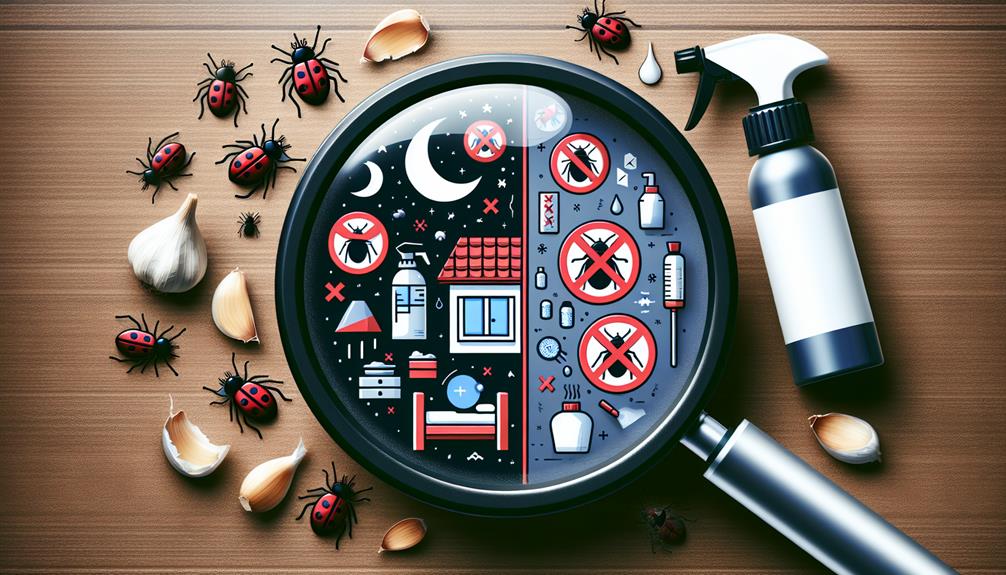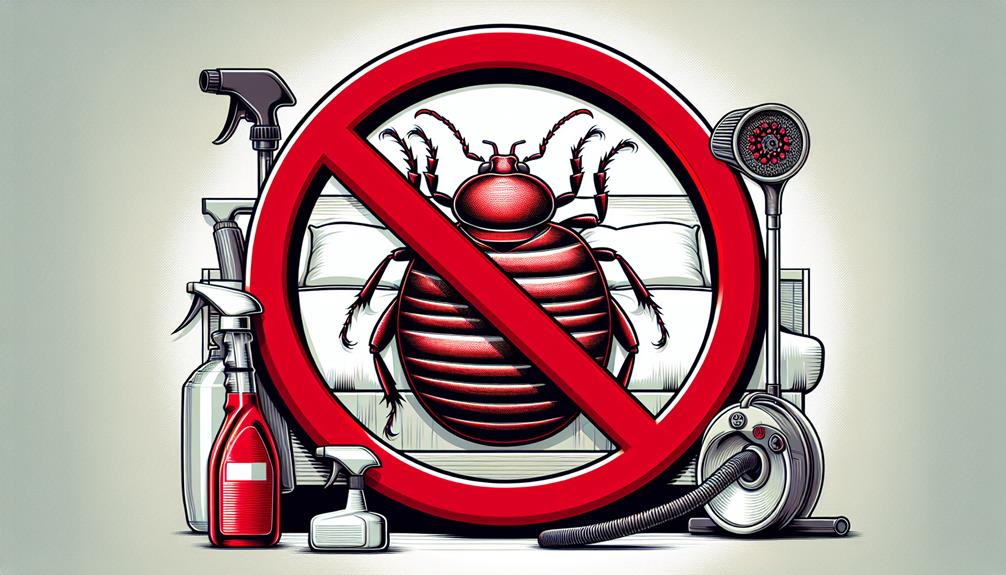Just when you thought your home was a sanctuary, you’ve discovered signs that bed bugs may have taken up residence.
It’s a common scenario that you’re not alone in facing, and there’s a comprehensive battle plan awaiting your command.
As you navigate through the complexities of understanding these persistent pests, you’ll uncover the telltale signs of an infestation, alongside proven prevention strategies that can fortify your defenses.
From DIY remedies that you can start today to professional treatment options that promise more permanent solutions, this guide is designed to arm you with knowledge.
But the journey doesn’t end with eradication; post-treatment care and debunking widespread myths will be crucial in keeping your home bed bug-free.
So, why should you keep exploring? What you learn next could be the turning point in your battle against bed bugs, ensuring that your victory is not just temporary but lasting.
Key Takeaways
- Bed bugs are small parasites that feed on the blood of humans and animals and have existed for thousands of years.
- Recognizing signs of bed bug infestation, such as bites, blood stains, and musty odor, empowers individuals to take swift action.
- Implementing prevention strategies, such as inspecting hotel beds, regularly vacuuming living spaces, and sealing cracks, is crucial to avoid bed bug infestations.
- Consulting with pest control professionals and implementing integrated pest management strategies are effective approaches for eradicating bed bugs and preventing reinfestation.
Understanding Bed Bugs

Bed bugs, scientifically known as Cimex lectularius, are small, elusive parasites that thrive by feeding on the blood of humans and animals, primarily during the night. Delving into bed bug history, you’ll find their presence has been documented for thousands of years, with these pests adapting alongside human civilization. This long-standing coexistence underscores not only their resilience but also their significant ecological impact.
Understanding the ecological role of bed bugs reveals a complex dynamic. While they’re often viewed negatively due to their parasitic nature, their existence points to the intricate balance within ecosystems. They serve as prey for certain predators, such as spiders and centipedes, thereby contributing to biodiversity. However, their role extends beyond mere participants in the food web. Bed bugs can influence human behaviour and habitats, driving efforts in pest management and influencing the development of safer, more effective control methods.
As you navigate the challenges bed bugs present, remember you’re part of a larger community facing similar issues. This shared experience fosters a sense of belonging, uniting us in the search for solutions that mitigate their impact while respecting our delicate ecological balance.
Signs of Infestation
Identifying an infestation starts with recognizing the subtle, yet distinct, signs that bed bugs leave behind. You’re not alone in this battle; understanding these signals can empower you to act swiftly.
Firstly, bite patterns hold crucial clues. Unlike random mosquito bites, bed bug bites often appear in a line or cluster, primarily on exposed skin during sleep. These bites can cause significant discomfort, including itching and swelling.
Moreover, infestation locations are pivotal in identifying their presence. Bed bugs are strategic, preferring areas close to their food source – you. Inspect your mattress seams, bed frames, and box springs meticulously. These pests also hide in cracks and crevices in walls, flooring, and furniture. Tiny blood stains on your sheets, dark or rusty spots of bed bug excrement on mattresses and bedding, and an offensive, musty odour from their scent glands are telltale signs.
Your keen observation of these signs is the first step in reclaiming your space from these unwelcome invaders. Understanding these indicators fosters a sense of community and shared knowledge, empowering us all in the battle against bed bugs.
Prevention Strategies

Having recognized the signs of a bed bug infestation, it’s crucial to explore effective strategies to prevent these pests from establishing a presence in your space. Implementing travel precautions forms the cornerstone of a proactive defence against bed bugs. When staying in hotels, always inspect the bed, headboard, and furniture for signs of bed bugs. Use luggage racks to keep your bags off the floor and consider encasing your luggage in protective covers to thwart any attempts by bed bugs to hitch a ride home with you.
Seasonal risks also play a pivotal role in bed bug prevention. During peak travel seasons, such as summer and holiday periods, the likelihood of bed bug encounters increases. This is due to the heightened movement of people and their belongings, which can inadvertently spread bed bugs. To mitigate these risks, it’s advisable to regularly vacuum your living spaces and inspect second-hand furniture or clothing before bringing them into your home. Seal cracks and crevices where bed bugs could potentially enter or hide.
DIY Remedies
For individuals seeking to combat bed bug infestations, various DIY remedies offer effective, scientifically-based solutions that can be implemented with household items.
Among these, natural repellents and vinegar solutions stand out for their efficacy and ease of use.
Natural repellents, such as essential oils derived from plants like lavender, peppermint, and tea tree, have been scientifically proven to deter bed bugs. These oils disrupt the pests’ neural pathways, effectively repelling them without harming humans or pets. To create a natural repellent spray, you’ll need to mix a few drops of your chosen essential oil with water in a spray bottle. Apply this solution around potential entry points and resting areas to create an unwelcoming environment for bed bugs.
Vinegar solutions offer another accessible DIY remedy. The acetic acid in vinegar is a potent natural contact pesticide, capable of killing bed bugs on contact. By filling a spray bottle with white vinegar and applying it directly to the infested areas, you can eradicate visible bed bugs. However, it’s important to note that vinegar solutions are more effective when combined with other pest control methods, as they mightn’t reach hidden bugs or eggs.
These DIY remedies, when applied with diligence and in conjunction with professional advice, can significantly reduce bed bug populations, fostering a sense of belonging and control over your living space.
Professional Treatment Options

While DIY remedies offer a starting point in addressing bed bug infestations, consulting with pest control professionals provides a more comprehensive and scientifically rigorous approach to eradication. You’re not alone in this battle; joining forces with experts ensures you’re part of a community committed to reclaiming your space from these unwelcome guests.
Professionals employ a variety of methods, each with its own merits, carefully considering chemical safety and treatment duration to minimize disruption in your life. Integrated Pest Management (IPM) strategies prioritize your health and environmental well-being, using chemicals only as a last resort. This approach involves a detailed inspection, followed by mechanical methods like vacuuming and heat treatment, which prove highly effective against bed bugs at all life stages.
Chemical treatments, when needed, are applied with precision and expertise, ensuring safety for you and your family. The duration of these treatments varies, but rest assured, the goal is to provide a lasting solution. Continuous monitoring and follow-up treatments are part of the package, ensuring that the bed bugs don’t make an unwelcome return.
Post-Treatment Care
After professional bed bug treatment, diligent post-treatment care is essential to prevent reinfestation and ensure the long-term efficacy of the eradication efforts.
Part of this care involves making critical laundry adjustments. You’ll need to wash all your fabrics, including bedding, curtains, and clothes, in hot water and then dry them on the highest heat setting possible. This process kills any lingering bed bugs or eggs, significantly reducing the risk of a resurgence.
Room redesign also plays a pivotal role in post-treatment care. By minimizing clutter, you eliminate potential hiding spots for bed bugs, making it harder for them to reestablish a foothold in your space. Consider selecting furniture with smooth surfaces and simple designs, as these are less likely to harbour bed bugs compared to complex, ornate pieces.
Furthermore, placing bed bug-proof covers on mattresses and box springs can create an impenetrable barrier against these pests.
Engaging in these practices fosters a sense of community and shared responsibility in the fight against bed bugs. By adhering to these guidelines, you’re not just protecting your own home; you’re contributing to the broader effort to keep our living environments safe and bed bug-free.
Myths Debunked

Shifting focus from post-treatment care, let’s tackle the common misconceptions surrounding bed bug management. You might’ve heard about the notion of bite immunity, suggesting that some people are naturally resistant to bed bug bites. Scientifically, this is a myth. Everyone is susceptible to bed bug bites; however, reactions vary greatly among individuals. The difference lies not in immunity but in how one’s body responds to the bites. Some may exhibit severe reactions, while others mightn’t show any signs at all, creating a false perception of immunity.
Another widespread myth is moonlight repulsion, where it’s believed that bed bugs are repelled by moonlight and thus, are only active in its absence. This isn’t grounded in scientific truth. Bed bugs are indeed nocturnal, but their activity isn’t influenced by moonlight. They’re primarily driven by the carbon dioxide exhaled by humans during sleep, which means their peak feeding times coincide with our sleeping hours, regardless of moonlight presence.
Understanding these misconceptions is crucial in fostering a sense of belonging amongst those battling bed bug infestations. By dispelling myths, we can approach bed bug management with knowledge and unity, enhancing our collective efforts to combat these pests effectively.
Staying Bed Bug-Free
To maintain a bed bug-free environment, it’s essential to implement proactive strategies and adhere to best practices in pest management. One critical aspect of this effort involves adopting rigorous travel precautions. As you venture into new environments, you’re unknowingly exposed to potential bed bug infestations.
Scientifically speaking, bed bugs are adept hitchhikers, finding refuge in your luggage and personal belongings. To safeguard against this, always inspect your accommodation’s bedding, furniture, and even behind-wall art for signs of bed bugs upon arrival. Utilize luggage racks to keep your belongings off the floor, and consider encasing your suitcase in a protective cover.
Equally important are the laundry tips that play a pivotal role in bed bug prevention. Studies have shown that high temperatures can effectively eliminate bed bugs, so washing your clothing and bedding at a minimum of 60°C (140°F) and then drying them on a high heat setting is crucial after travelling. For items that can’t withstand high temperatures, freezing them for at least 72 hours has been proven to be an effective alternative.
You may also enjoy reading this article
Was This Article Helpful?
- Please provide feedback and comments to help us improve our content.
- Share your experiences and any additional tips you have for dealing with pests.
Share this Post


